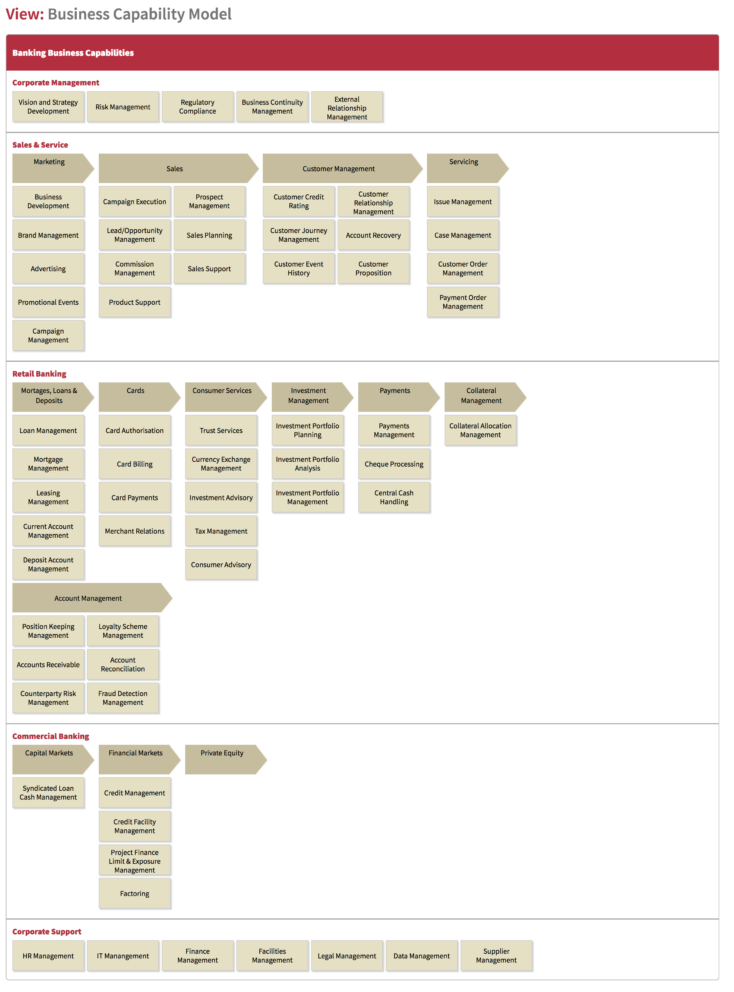Business Capability Modelling
10 min
Understanding the capabilities required by your business provides a high-level overview of the business and can be a very useful exercise as it allows one to take a step back and focus on what the key elements of the business are. You can avoid getting bogged down in the details of ‘how’ things happen and concentrate on ‘what’ does (or needs to) happen. Once you have done this, it is possible to identify your key capabilities, for example, the ones that will differentiate your business, and you can use this information to ensure that you focus on the areas of importance in your business, whether this is in defining new projects or ensuring business as usual delivers appropriately.
We use Business Capabilities to model the services that a business or enterprise offers or requires. These capabilities are modelled in the Business Conceptual layer and represent what the business does (or needs to do) to fulfil its objectives and responsibilities.
The Business Capabilities are the top layer of the business architecture. They belong to a Business Domain and are governed by the Business Principles of the organisation. The capabilities are realised by a business process.
The gives an example of how you can use a capability model, in this case, to show duplication of applications – the capability model is the anchor to highlight where duplication exists and the potential for rationalisation, which is often of interest to senior management. If you click through to the capability summary you can also see the processes that support it and the applications each process uses.
Business Capabilities can themselves be broken down into supporting capabilities if this is useful. In the banking business reference model, shown below, you can see the parent and child capabilities. These are all examples of capabilities, or services, that an organisation needs to perform to enable it to fulfil its obligation to its customers.

You will find that your business capabilities are relatively static because you are defining the ‘what’ which rarely changes whereas, for example, your business processes will constantly be evolving as the ‘how’ things are done changes all the time with the advancement of technology and customer demand. A very obvious example is retail – twenty years ago the internet did not exist so there were no online sales channels, but the capabilities of a retail channel have not altered; Sales, Fulfilment and Billing are still capabilities, however, the process of ‘how’ they sell, dispatch and take payment has altered dramatically.
The level at which you model your business capabilities will depend on your objectives – ask why you are carrying out the modelling exercise and that will give you ideas as to where to stop. Sometimes it can be useful to use the capabilities to model the key value chain of the business – the key chain of capabilities, or services, that flow through your business. This is usually modelled at a fairly high level and is a subset of all the capabilities, as it will not usually include any of the support functions such as IT or HR. It can be useful to highlight what the areas of most importance are to the business and to provide some focus. However, if a particular area has been identified as an area for change, you should focus on this area and model the capabilities down to the level where they meet the processes and people that support them. It depends on your objectives at the time.
Capturing Capabilities
Once you have defined the capabilities for the area you are working on, you can enter them into Essential. To create the Business Reference model, you need to define the parent/child relationships and also define where in the model (when it is rendered in a View) you want the capability to appear – Manage, i.e. management capabilities, define the top layer, Back, i.e. back-office capabilities, define the bottom layer and Front defines the capabilities specific to the model you are creating. You can also use the Business Capability Index to define the order that the capabilities will appear in the model.
Business Capabilities are usually linked to the Domains they belong to, the Principles that guide their delivery, the Strategic Goals they support and the Processes that implement them. You should enter as much information as you have at the time.
Capturing Your Business Reference Model in Essential
Updated 22 January 2024
